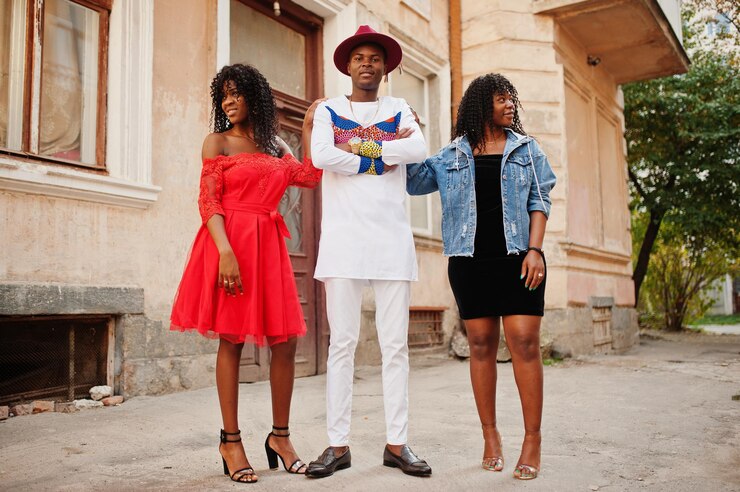The world of fashion is a tapestry, rich and diverse, woven with cultural narratives from across the globe. Within this vibrant mosaic, African fashion dresses stand out—vivid, dynamic, and bursting with life. These dresses are not just pieces of clothing; they are storytellers, each one echoing the rich traditions of the continent. But how did these traditional garments evolve into the stunning contemporary fashion we see today? Let’s unravel this story, exploring the deep roots and blossoming branches of African fashion.
A Brief History of African Fashion
African fashion, deeply rooted in the continent’s rich history, has always been a symbol of identity and social status. Historically, African attire was made from materials that were locally available, such as animal skins and woven grass. Over time, the introduction of new fabrics and technologies, like cotton and dyeing techniques, led to the development of more sophisticated garments.
The significance of African fashion stretches far beyond the continent’s borders. From ancient times to the present, African textiles have traveled the world, influencing various cultures. Today, African fashion is celebrated globally, not only for its aesthetic appeal but also for its ability to tell stories and convey cultural heritage.
The Evolution of African Fashion Dresses
In the past, African fashion dresses were primarily functional, designed for specific ceremonies and climates. Traditional garments such as the boubou, kaftan, and dashiki were integral to cultural ceremonies and daily wear. These outfits were often made from natural materials like bark cloth and raffia, dyed with colors derived from local plants and minerals.
However, the winds of change have blown through African fashion, transforming these traditional attires into contemporary masterpieces. Today, African fashion dresses blend the old with the new, incorporating Western influences while maintaining their cultural essence. Designers are experimenting with silhouettes, embellishments, and new fabrics, creating a fusion that resonates with modern fashionistas around the world.
Popular African Dress Styles
One cannot discuss African fashion without mentioning the iconic styles that have captured the imagination of many. Among these is the vibrant kente cloth from Ghana, recognized for its bold patterns and bright colors. Another popular style is the Nigerian ankara print, known for its versatility and striking motifs.
The South African shweshwe is another beloved fabric, distinguished by its intricate geometric patterns. These fabrics, along with others like batik and bogolan, form the foundation of many African fashion dresses. Each piece is a work of art, imbued with patterns and colors that reflect the heritage and identity of the wearer.
Influences on African Fashion

African fashion is a melting pot of influences, drawing from cultural, social, and environmental factors. The continent’s diverse cultures, each with distinct traditions and aesthetics, provide a rich tapestry of inspiration for designers. Social movements have also played a significant role, with fashion often used as a medium for political and social expression.
Environmental factors influence the choice of materials and designs, with eco-friendly practices gaining momentum. Many designers are now using sustainable materials and traditional crafting methods to create their garments, ensuring that African fashion dresses not only look good but also do good for the planet.
Leading African Fashion Designers
The rise of African fashion has been propelled by visionary designers who have brought the continent’s style to the global stage. Names like Ozwald Boateng, Duro Olowu, and Lisa Folawiyo have become synonymous with innovative design and craftsmanship. These designers draw from their heritage, infusing their creations with the vibrancy and spirit of Africa.
Their impact extends beyond just clothing, as they challenge stereotypes and promote diversity within the fashion industry. By bridging cultural divides, these designers have made African fashion dresses a staple in wardrobes around the world.
The Future of African Fashion
The future of African fashion is as bright as its colorful fabrics. Sustainability is at the forefront, with designers increasingly committed to eco-friendly practices. The global reach of African fashion is also expanding, with more international collaborations and fashion shows showcasing the continent’s talent.
Trends suggest that the demand for African fashion dresses will continue to grow, as consumers seek unique and meaningful pieces. The fusion of tradition and modernity will remain a key theme, with designers pushing boundaries to create innovative and inspiring collections.
How to Wear African Fashion Dresses
Incorporating African fashion into your wardrobe can be both fun and rewarding. Start by selecting versatile pieces that can be dressed up or down. For casual outings, pair an ankara skirt with a simple top, or add a shweshwe scarf to your ensemble for a touch of flair.
For formal occasions, consider a tailored boubou or a sleek kaftan. Accessories are essential—think statement jewelry and bold headwraps. The key is to balance the vibrant patterns with neutral tones, allowing the African elements to shine.
Where to Buy African Fashion Dresses
Finding authentic African fashion dresses is easier now, thanks to online platforms and stores dedicated to showcasing the continent’s designs. Websites like Afrikrea and The Folklore offer a wide range of options, connecting buyers with artisans and designers from across Africa.
For those who prefer in-person shopping, boutiques in major cities often carry African fashion lines. Whether online or offline, the emphasis is on supporting sustainable practices and fair trade, ensuring that the beauty of African fashion is preserved for generations to come.
Celebrating the Beauty of African Fashion
In conclusion, African fashion dresses are more than just garments—they are a celebration of culture, creativity, and history. Their ability to weave tradition into modernity makes them a unique and valuable addition to any wardrobe. As the world becomes more interconnected, the influence of African fashion continues to grow, enriching the global fashion landscape.
For those eager to explore further, consider attending African fashion events or engaging with the community through social media. By doing so, you not only discover the elegance of African fashion but also contribute to its vibrant and dynamic narrative.

